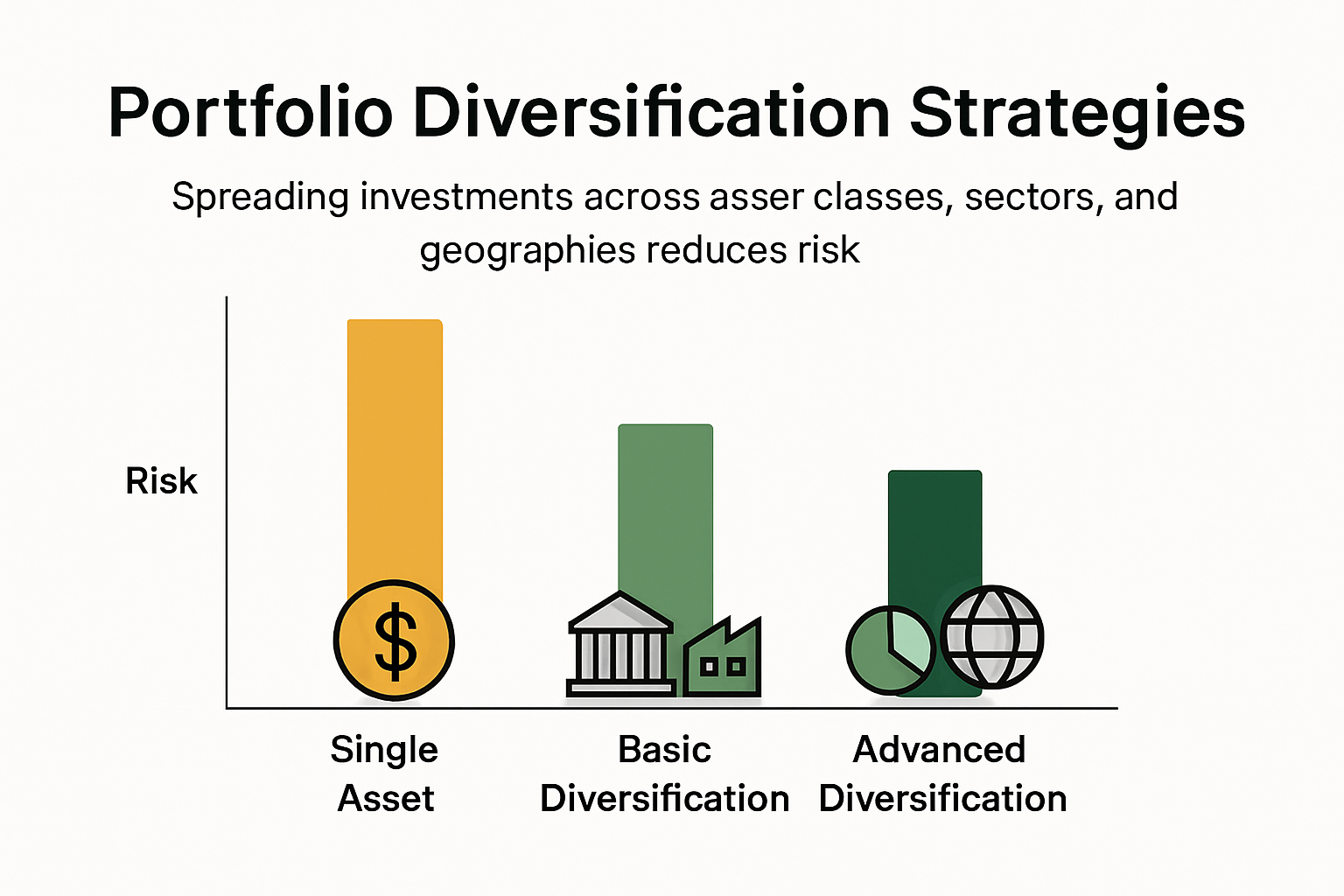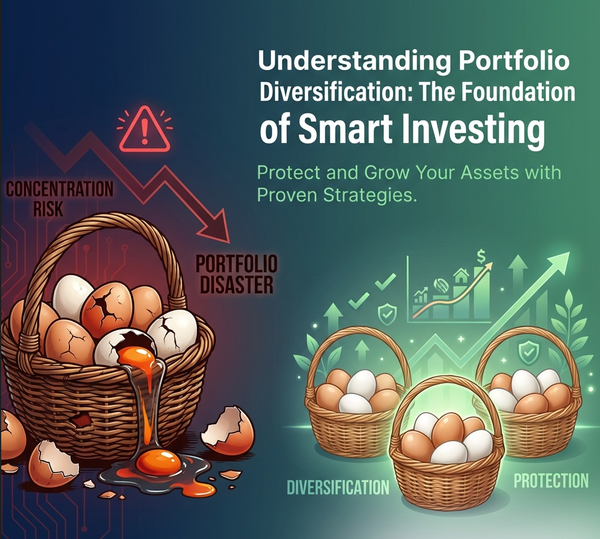Top Portfolio Diversification Strategies for 2025

Investors keep hearing that spreading money across different assets can help weather tough times and unpredictable markets. But even after all this advice, portfolios that stuck to the classic 60/40 stock-bond split underperformed during recent shocks, showing up to 35 percent more volatility compared to portfolios with broader diversification. Turns out, blindly following old-school diversification rules could be riskier than doing nothing at all. The smartest strategies for 2025 are breaking away from tradition and looking for hidden ways to make portfolios both steadier and more resilient.
Table of Contents
- Why Diversification Matters For Investors
- Types Of Portfolio Diversification Strategies
- Practical Steps To Diversify Your Portfolio
- Common Mistakes And How To Avoid Them
Quick Summary
| Takeaway | Explanation |
|---|---|
| Diversification is essential for risk management | Spreading investments across various assets lowers risk from market volatility and poor performance of any single investment. |
| Dynamic strategies optimize asset allocation | Adapting your investment approach to changing market conditions can enhance returns and stability during uncertainty. |
| Understand and set clear investment goals | Align your strategy with specific financial objectives to ensure your portfolio evolves according to your needs. |
| Rebalance your portfolio regularly | Adjust your asset mix periodically to maintain your desired risk profile and performance balance. |
| Avoid overconcentration in familiar markets | Diversifying across sectors and geographies minimizes risks associated with specific areas or companies. |
Why Diversification Matters for Investors
Investors face a complex financial landscape where protecting and growing wealth requires strategic thinking. Portfolio diversification isn't just a recommendation - it's a critical defense mechanism against market unpredictability.
The Risk Mitigation Principle
Understanding portfolio diversification starts with recognizing investment risk. The University of Colorado emphasizes that markets are inherently unpredictable, making diversification a fundamental strategy for managing potential financial volatility. By spreading investments across multiple asset classes, sectors, and geographic regions, investors can significantly reduce the impact of any single investment's poor performance.
Consider a scenario where an investor has concentrated all funds in one technology stock. If that company experiences a significant downturn, the entire investment portfolio could collapse. Diversification acts as a protective shield, ensuring that potential losses in one area can be offset by stability or gains in another.

Economic Uncertainty and Portfolio Resilience
Research published in the Future Business Journal provides compelling evidence of diversification's importance during economic disruptions. During the COVID-19 pandemic, portfolios with diversified assets demonstrated remarkable resilience. They experienced less dramatic fluctuations and maintained more consistent risk-adjusted returns compared to non-diversified investment strategies.
This resilience isn't just about preventing losses - it's about maintaining consistent growth potential. Diversification allows investors to capture opportunities across different market segments while simultaneously protecting against concentrated risks. Whether it's technology, healthcare, real estate, or international markets, a well-structured portfolio can adapt to changing economic conditions.
Strategic Wealth Building
Britannica Money explains that diversification isn't merely a defensive strategy but a proactive approach to wealth accumulation. By participating in various growth opportunities, investors can potentially enhance long-term returns while maintaining a balanced risk profile.
Effective diversification requires continuous assessment and rebalancing. Markets evolve, economic conditions shift, and investment landscapes transform. Successful investors recognize that diversification is not a one-time activity but an ongoing process of strategic allocation and risk management.
The goal is not to eliminate risk entirely - which is impossible - but to create a robust investment framework that can weather different market conditions. A truly diversified portfolio reflects an investor's understanding that financial success comes from intelligent, calculated risk-taking rather than attempting to predict impossible market movements.
Types of Portfolio Diversification Strategies
Portfolio diversification is not a one-size-fits-all approach. Investors have multiple strategies to spread risk and optimize potential returns across different investment landscapes.
Asset Class Diversification
Research from Springer highlights the critical importance of diversifying across different asset classes to manage financial risk effectively. This strategy involves spreading investments across stocks, bonds, real estate, commodities, and other financial instruments. Each asset class responds differently to market conditions, creating a buffer against potential losses.
Stocks might offer high growth potential but come with higher volatility. Bonds provide stability and consistent income. Real estate can generate rental revenue and appreciate over time. Commodities like gold often serve as a hedge against inflation. By combining these assets, investors can create a more resilient portfolio that can withstand market fluctuations.
Below is a table summarizing the roles and characteristics of major asset classes mentioned in the article to help compare their diversification benefits:
| Asset Class | Typical Role in Portfolio | Potential Benefit | Common Risks |
|---|---|---|---|
| Stocks | Growth | High return potential | Market volatility |
| Bonds | Stability, income | Lower risk, steady income | Interest rate, credit risk |
| Real Estate | Income, appreciation | Rental income, inflation hedge | Illiquidity, market downturn |
| Commodities | Inflation hedge, diversification | Protection in downturns | Price swings, no income |

Dynamic Portfolio Optimization
An innovative study from ArXiv introduces the Adaptive Minimum-Variance Portfolio framework, which represents a sophisticated approach to portfolio management. This strategy goes beyond traditional static allocation by dynamically adjusting investments based on changing market conditions.
The adaptive approach allows investors to respond quickly to emerging market trends, economic shifts, and potential risks. Instead of maintaining a rigid investment structure, this method continuously rebalances portfolios to minimize variance and optimize returns. Such dynamic strategies can be particularly effective during periods of economic uncertainty, allowing for more responsive and intelligent investment management.
Advanced Diversification Techniques
Cutting-edge research has introduced innovative metrics like the lexical ratio, which utilizes textual data to assess portfolio diversification. This approach represents the evolving landscape of investment strategies, incorporating advanced analytics and data science techniques.
Modern diversification strategies are not limited to traditional asset allocation. Investors now have access to sophisticated tools that can analyze market sentiment, track economic indicators, and provide nuanced insights into potential investment opportunities. These advanced techniques allow for more granular risk management and potentially more precise portfolio construction.
Successful diversification requires a comprehensive understanding of individual investment goals, risk tolerance, and market dynamics. While these strategies provide a framework, investors should always consider their unique financial circumstances and potentially consult with financial professionals to develop a tailored approach.
Practical Steps to Diversify Your Portfolio
Building a robust investment portfolio requires strategic planning and intentional asset allocation. Investors must move beyond traditional approaches to create a truly resilient financial strategy.
Understanding Your Investment Goals
Forbes Finance Council recommends starting with a clear assessment of your financial objectives. This means identifying both short-term and long-term investment goals. Are you saving for a home purchase in three years? Planning for retirement in two decades? Each goal requires a different approach to risk and asset allocation.
Short-term goals demand more conservative investments with lower volatility. Investments targeted at distant future objectives can tolerate more market fluctuations. By aligning your investment strategy with specific timeframes, you create a more intentional and flexible portfolio that can adapt to changing financial needs.
Below is a table summarizing the key steps and considerations for diversifying your portfolio, supporting investors in moving from planning to implementation:
| Step | Description | Importance |
|---|---|---|
| Define investment goals | Clarify short- and long-term objectives | Aligns assets with needs |
| Assess risk tolerance | Determine comfort with price fluctuations | Ensures appropriate allocation |
| Analyze asset correlation | Choose assets that react differently to market events | Improves diversification |
| Allocate strategically | Spread investments across assets, sectors, regions | Reduces risk concentration |
| Explore alternative assets | Consider annuities, real estate, commodities, etc. | Enhances risk-adjusted returns |
| Rebalance regularly | Adjust allocation to maintain desired risk profile | Keeps strategy on track |
Asset Correlation and Strategic Allocation
U.S. Bank research highlights the critical importance of understanding asset correlation. Simply owning multiple investments isn't enough - those investments must behave differently under various market conditions. Positive correlation means assets move similarly, reducing the effectiveness of diversification.
For instance, high-yield bonds often correlate closely with stocks, meaning they might decline simultaneously during market downturns. A truly diversified portfolio requires assets that respond independently to economic changes. Historically, a balanced approach combining 60% stocks and 40% bonds has demonstrated more consistent performance compared to an all-stock portfolio.
Beyond Traditional Diversification
Kiplinger's financial insights reveal that traditional 60/40 stock-bond portfolios are becoming less effective in todays complex financial landscape. Modern investors must explore alternative investment vehicles that offer unique risk management capabilities.
Consider incorporating assets like indexed annuities, which provide market exposure with downside protection. Explore investments in real estate, commodities, or international markets to further spread risk. Some investors might find value in emerging market funds, cryptocurrency-related instruments, or sector-specific exchange-traded funds (ETFs).
The key is creating a personalized strategy that reflects your individual risk tolerance, financial goals, and market understanding. While diversification can't eliminate investment risk entirely, it can significantly mitigate potential losses and create more stable long-term growth opportunities.
Remember that portfolio diversification is not a one-time event but an ongoing process. Regular review and rebalancing ensure your investment strategy remains aligned with your evolving financial landscape. Consider consulting with a financial professional who can provide personalized guidance tailored to your specific circumstances.
Common Mistakes and How to Avoid Them
Investors often encounter pitfalls that can significantly undermine their portfolio diversification efforts. Understanding and avoiding these common mistakes is crucial for maintaining a robust investment strategy.
Overconcentration and Familiarity Bias
Kiplinger's research reveals that many investors unconsciously limit their portfolio by avoiding international markets. This phenomenon, known as home bias, leads investors to overemphasize domestic companies they feel familiar with, inadvertently reducing their portfolio's potential for diversification.
Overconcentration can occur in multiple ways. Some investors load up on stocks from a single sector, like technology, or concentrate investments in their employer's company stock. This approach creates significant vulnerability. If that particular sector experiences a downturn or the company faces challenges, the entire investment strategy could be compromised. True diversification requires spreading investments across different sectors, geographies, and asset classes to minimize risk.
Neglecting Portfolio Rebalancing
Static portfolios become increasingly misaligned with original investment goals over time. Market performance causes different assets to grow at varying rates, which can skew your initial asset allocation. Without periodic rebalancing, your portfolio may drift from its intended risk profile.
Effective rebalancing involves systematically adjusting your investment mix to maintain your desired asset allocation. This might mean selling overperforming assets and reinvesting in underperforming ones. While counterintuitive, this strategy helps maintain your original risk tolerance and can potentially improve long-term returns.
Misunderstanding Risk and Complexity
Financial experts emphasize that today's investment landscape requires a nuanced understanding of risk. Traditional approaches like the simple 60/40 stock-bond portfolio are increasingly inadequate in managing modern financial complexities.
Investors often mistake complexity for sophistication. Adding numerous investments doesn't automatically create effective diversification. Each additional asset should serve a specific strategic purpose. Sometimes, a more focused portfolio with carefully selected investments can outperform a sprawling, unfocused collection of assets.
Another critical mistake is misaligning investment choices with personal risk tolerance and financial goals. What works for one investor might be entirely inappropriate for another. Some investors chase high-risk, high-reward strategies without fully understanding potential downsides. Others become overly conservative, potentially missing growth opportunities.
The most successful investors approach diversification as a personalized, dynamic process. They remain adaptable, continuously educate themselves about market trends, and are willing to seek professional guidance when needed. Remember that diversification isn't about eliminating risk entirely - it's about managing risk intelligently to support your long-term financial objectives.
Frequently Asked Questions
What is portfolio diversification?
Portfolio diversification is the practice of spreading investments across various asset classes, sectors, and geographic regions to reduce risk and enhance returns.
Why is diversification important for investors in 2025?
Diversification is crucial for managing risk amidst economic uncertainty and market volatility. It helps protect against significant losses in any single investment and promotes more consistent long-term growth.
What are some common portfolio diversification strategies?
Common strategies include asset class diversification, dynamic portfolio optimization, and advanced techniques that utilize modern analytics and market sentiment analysis.
How often should I rebalance my portfolio for optimal diversification?
Investors should regularly rebalance their portfolios, ideally at least once a year or when significant market changes occur, to maintain their desired asset allocation and risk profile.
Upgrade Your Diversification Strategy with Real-Time AI Insights
Has your classic portfolio left you exposed to sudden market shifts? The article showed how traditional 60/40 approaches often fall short, especially when markets become unpredictable. With volatility on the rise and new risks emerging, simply spreading your money is not enough. You need smarter, adaptive strategies that keep up with the pace of change. If you want a portfolio that truly protects your investments and seizes new opportunities, it is time for a new toolset.

Unlock the full potential of your portfolio with StocksageAI. Let artificial intelligence turn market data into actionable insights, helping you optimize allocations, spot hidden risks, and rebalance before trouble hits. Make 2025 your year for smarter diversification. Discover how our AI-powered platform transforms analysis into clear recommendations. Get started now at StocksageAI and take control of your investment future.




